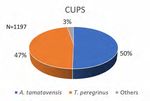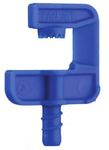Predatory mites in citrus under protective screen
←
→
Page content transcription
If your browser does not render page correctly, please read the page content below
Figure 1. A phytoseiid mite (left) feeds on a female citrus red mite (right).
Predatory mites in
citrus under protective screen
By Emilie Demard
M
anaging the Asian citrus control from functioning, as observed studies helps develop sustainable strat-
psyllid (ACP), a vector of in outdoor systems. egies for managing pests in CUPS.
huanglongbing (HLB), Yet, predatory mites can enter and
is critical for reducing establish in CUPS. Predatory mites STUDY SETUP
disease incidence and improving represent essential natural enemies An experimental commercial-scale
tree health. Growing citrus under that can control several citrus pests by trial was established in 2013 at the
screened structures, referred to as cit- feeding on their eggs University of Florida
rus under protective screen (CUPS), or immatures. Those in Institute of Food and
protects trees from ACP and HLB.
CUPS provides an opportunity to
the family Phytoseiidae,
also called phytoseiids,
Leafminers, Agricultural Sciences
(UF/IFAS) Indian River
produce premium-quality fresh fruit can feed on spider mites scales, Research and Educa-
by preventing psyllids and HLB from (Figure 1), rust mites tion Center (IRREC)
infecting the trees. and small soft-bodied mealybugs, in Fort Pierce. The
However, while CUPS effectively
keeps psyllids away, pests smaller
insects such as thrips,
whiteflies and psyllids.
thrips and mites setup consists of four
enclosed screen houses
than the 50-mesh (0.3 millimeter) To further understand are observed (30.5 meters wide by
screen can enter the structure and
damage trees and fruit. Leafminers,
their benefits, phyto-
seiid populations were
in CUPS. 36.5 meters long by 4.3
meters tall) and four
scales, mealybugs, thrips and mites are studied over a period open-air systems (23
observed in CUPS. Moreover, large of two years in CUPS meters wide by 27.5
natural enemies such as ladybeetles, and traditional open-air production meters long each) as controls. Ray Ruby
lacewings or spiders are excluded, systems for abundance and species grapefruit on two rootstocks (sour
which prevents natural biological assemblage. Knowledge from such orange and US-897) were planted in
14 Citrus Industry March 2021two systems (in-ground and potted)
at a density of 1,957 trees per hectare.
Mean number of phytoseiids per tap sample
Each CUPS was planted with 128 trees
and the control with 96 trees, for a total
of 896 trees.
MONITORING AND
IDENTIFICATION
Phytoseiids were sampled with
the tap sample method once per
month from August 2018 to July 2020.
Twenty randomly selected trees from
each CUPS or control were sampled.
Two tap samples per tree and 40 tap
samples per CUPS and control were
conducted. A 22- by 28-centimeter
black clipboard was used to conduct
tap sampling. The clipboard was held
horizontally under branches selected Figure 2. Seasonal abundance of phytoseiids in citrus under protective screen (CUPS) and
at random, which were struck three in the control from August 2018 to July 2020
times with a short piece of PVC pipe.
Mites were counted and collected SEASONAL ABUNDANCE observed in both systems in February
from the clipboard using a soft camel AND SPECIES ASSEMBLAGE of each year (Figure 2). In 2019, the
hairbrush and placed in vials contain- Overall, there was no significant numbers in CUPS were significantly
ing 80 percent ethanol and later in 60 difference in phytoseiid abundance higher than in the control (13.90 and
percent lactic acid overnight. Specimens between CUPS and the control. An 3.88 per tap sample, respectively). This
were mounted on slides in Hoyer’s average of 0.25 to 0.27 phytoseiids per trend reversed in February 2020 when
medium and identified in collaboration tap sample were collected. more phytoseiids were observed in the
with the taxonomist Ismail Döker. Two major population peaks were control than in the CUPS (11.53 and
Fan-Jet ® Single
Microsprinklers
Superior
Performance and Quality
Fan-Jet Single J4 - 14 Stream “Fill In”
• Better fill-in pattern
• More water in the first two feet
• Uniform distribution between streams
• Uniform stream lengths
Fan-Jet Single M - 330º Flat Mist
• 10º larger wetted area
• Uniform flat mist pattern
BOWSMITH INC. Tel: 863-453-6666
100 W. Monroe St. USA S.E.: 800-638-2593
PO Box 1663 Fax: 863-452-0386
Serving Florida since 1977! Avon Park, FL 33826 www.bowsmith.com
Citrus Industry March 2021 15Figure 3. Relative abundance of phytoseiid mites in citrus under Figure 4. Relative abundance of phytoseiid mites in the control
protective screen (CUPS)
5.68 per tap sample, respectively). This systems is encouraging, notably when of the specimens collected) followed
increase in the phytoseiid population those systems also received insecticide by Amblyseius tamatavensis (34.2
coincided with the bloom period, sug- sprays to manage pest mites and insects. percent). While A. tamatavensis was
gesting that citrus pollen may be an Two dominant species of phyto- more abundant in CUPS (50 percent)
alternative food for these arthropods, seiids were identified from the CUPS compared to the control (16 percent),
which may be useful for their biological and the control (Figure 3 and Figure T. peregrinus was more abundant in the
parameters, such as reproduction. The 4). Typhlodromalus peregrinus was the control (82 percent) than in the CUPS
high incidence of phytoseiids in both most abundant species (63.1 percent (47 percent). Other species including
Good Morning
Good night
Wake up to incredible harvests with the best nutrients you can
provide for your crops with BIOMIN®’s top of the line organic chelated
minerals with amino acids. Quickly correct nutrient deficiencies and
allow plants to flourish from better nutrient absorption during critical
and fast-growing periods. Get a good night’s rest knowing your crops are in good
hands with patented slow-release phosphorus fertilizers
Available nutrients: B, Ca, Cu, Fe, K, Mg, Mn, Mo, N, and Zn. from PHOSGARD® for both immediate and long-lasting
effect, providing optimal conditions for root development,
crop maturation, flowering, fruiting, and crop quality.
PHOSGARD® 0-28-25 / 0-60-0 / 2-40-16 / 4-25-15
PHOSGARD® PLUS / PHOSGARD® BIO
Ask Your Distributors About
Learn more at jhbiotech.com | (805) 650-8933
16 Citrus Industry March 2021Typhlodromips dentilis, Proprioseiopsis
mexicanus and Amblyseius aerialis were
2.7 percent of the total complex.
IMPLICATIONS FOR
BIOLOGICAL CONTROL
Finding equal or better levels of
phytoseiid mites in CUPS rather than
in the open-air system is encouraging.
Both species are generalist predators
that can feed on mites, small insects
(thrips, whiteflies) and pollen.
T. peregrinus is native to Florida.
This species had been found in the
canopies of citrus groves at differ-
ent Florida locations. T. peregrinus is
known to feed on the citrus red mite
and the citrus rust mite, two pest spe-
cies that are common in CUPS and
open production systems.
The first report of A. tamatavensis
in Florida was on tomatoes in 2018.
A. tamatavensis feeds on the citrus red
mite, but its potential against the citrus
rust mite is not known.
Releasing predatory mites in CUPS
could suppress mite and insect pests
and reduce the need for insecticides.
The environment in CUPS is
warm and humid compared to
open-air systems. It seems that both
A. tamatavensis and T. peregrinus
were able to survive in that environ-
ment; however, A. tamatavensis was
more abundant in the CUPS than in
the open-air system. The spike in pop-
ulations during bloom indicates that
the provision of alternate foods such
as pollen could maintain the pred-
atory mite populations in CUPS.
Pests such as mites, mealybugs, scales
and sooty mold may have served as
additional food sources to sustain the
phytoseiid populations.
UF/IFAS work with A. swirskii, a
commercially available species, showed
that it fed, developed and reproduced
on cattail and olive pollen, as well as
the citrus red mite. Further studies
are needed to evaluate the potential of
phytoseiids such as A. tamatavensis and
T. peregrinus to control pest mites and
other small insects.
Emilie Demard is a Ph.D. candidate
at the UF/IFAS IRREC in Fort Pierce,
working under the supervision of assis-
tant professor Jawwad Qureshi at the
UF/IFAS Southwest Florida Research
and Education Center in Immokalee.
Citrus Industry March 2021 17You can also read


























































